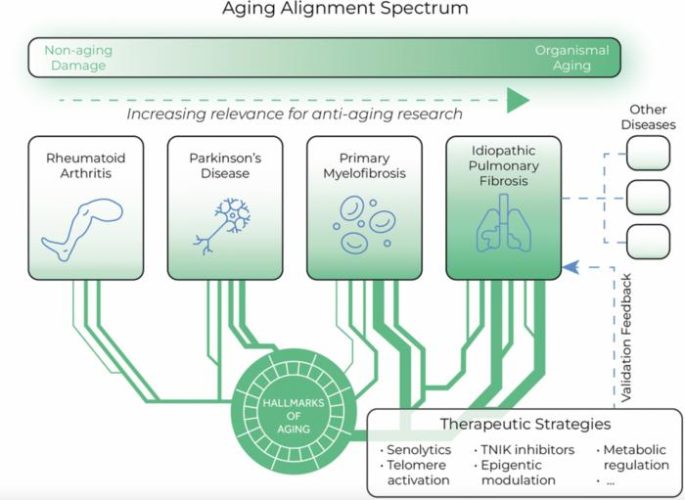Scientists spotlight lung disease as fast-track model for ageing drugs
Posted: 9 September 2025 | Drug Target Review | No comments yet
Researchers have identified idiopathic pulmonary fibrosis (IPF) as a powerful model for exploring treatments that target the biology of ageing.


A new study from Insilico Medicine, the Buck Institute for Research on Aging and Duke University suggests that idiopathic pulmonary fibrosis (IPF), a severe lung condition, could serve as one of the most promising models for testing anti-ageing drugs. The findings may have important implications for the future of pharmaceutical development for age-related diseases.
Published in Aging, the paper sets out a new framework for aligning disease-specific treatments with broader geroprotective strategies.
“In this review, we propose hallmark decomposition as a method of measuring the potential of a therapy to translate from a disease-specific treatment to a general geroprotector,” the authors wrote.
From ageing biology to clinical practice
The team developed a scoring system to evaluate how closely diseases mirror the core hallmarks of ageing – processes such as inflammation, DNA instability and impaired cellular repair. Out of 13 common age-related diseases (ARDs) assessed, IPF emerged as one of the most strongly aligned with ageing biology.
This perspective explores how ageing-related diseases (ARDs) can serve as experimental platforms for discovering new geroprotective interventions.
“This perspective explores how ageing-related diseases (ARDs) can serve as experimental platforms for discovering new geroprotective interventions,” the authors added.
IPF is a chronic condition in which scar tissue builds up in the lungs, causing a rapid and often devastating decline in breathing capacity. Unlike the gradual decline typically seen in natural ageing, the progression of IPF is more than five times faster. Its strong mechanistic overlap with ageing means that it can function as a ‘fast-forward’ model, allowing researchers to observe, test and measure the effectiveness of therapies that target the root causes of ageing.


Conceptual framework showing how idiopathic pulmonary fibrosis (IPF) aligns most closely with ageing processes compared to other age-related diseases. The model highlights how IPF can be used both to inform disease-specific therapies and to validate interventions targeting ageing biology, including senolytics, telomere activation, TNIK inhibitors, epigenetic modulation and metabolic regulation. Credit: Zhavoronkov et al., 2025
The bidirectional framework
One of the key advantages highlighted in the study is IPF’s speed of progression and measurable outcomes. For clinical testing, this offers a rare efficiency: if a therapy demonstrates benefits in IPF patients, it could point to broader applicability for other age-related conditions such as arthritis, heart disease and diabetes.
The bidirectional framework allows insights from the biology of ageing to inform treatments for IPF, while evidence of efficacy in IPF can in turn help validate therapies with wider potential.
The authors also mapped several therapeutic strategies currently being investigated for IPF that could hold relevance far beyond lung disease. These include:
- Senolytics – drugs that selectively clear senescent or ‘zombie’ cells linked to tissue decline
- Telomere activation – therapies aimed at restoring the protective caps on chromosomes that shorten with age
- TNIK inhibitors and epigenetic modulators – compounds that target cell signalling and gene regulation
- Metabolic regulation – approaches that stabilise energy and repair processes within cells
Some of these, including senolytic drug combinations and AI-discovered molecules such as rentosertib, are already in preclinical or clinical testing, showing early signals of promise.
A pivot in pharmaceutical research
The conceptual framework presented in the paper emphasises that IPF has the strongest overlap with ageing of any ARD studied. The authors suggest this makes it a useful model for evaluating strategies that target underlying ageing mechanisms as well as disease symptoms. They add that effective treatments trialled in IPF could “translate across multiple ARDs,” creating a domino effect in how chronic diseases are tackled.
Powerful new tool for anti-ageing therapeutics
The research highlights a shift in how the pharmaceutical industry may approach ageing, viewing it less as an inevitable process and more as a factor that contributes to disease. The authors note that if IPF proves effective as a model, it could provide a practical way to test and develop therapies aimed at ageing biology.
By focusing on conditions such as IPF, scientists can identify and test interventions with a higher likelihood of translating into treatments for multiple age-related diseases, making the early stages of drug development more targeted and efficient.
Related topics
Analysis, Disease Research, Drug Development, Drug Discovery, Drug Discovery Processes, Epigenetics, Metabolomics, Translational Science
Related conditions
Idiopathic Pulmonary Fibrosis
Related organisations
Buck Institute for Research on Aging, Duke University, Insilico Medicine








